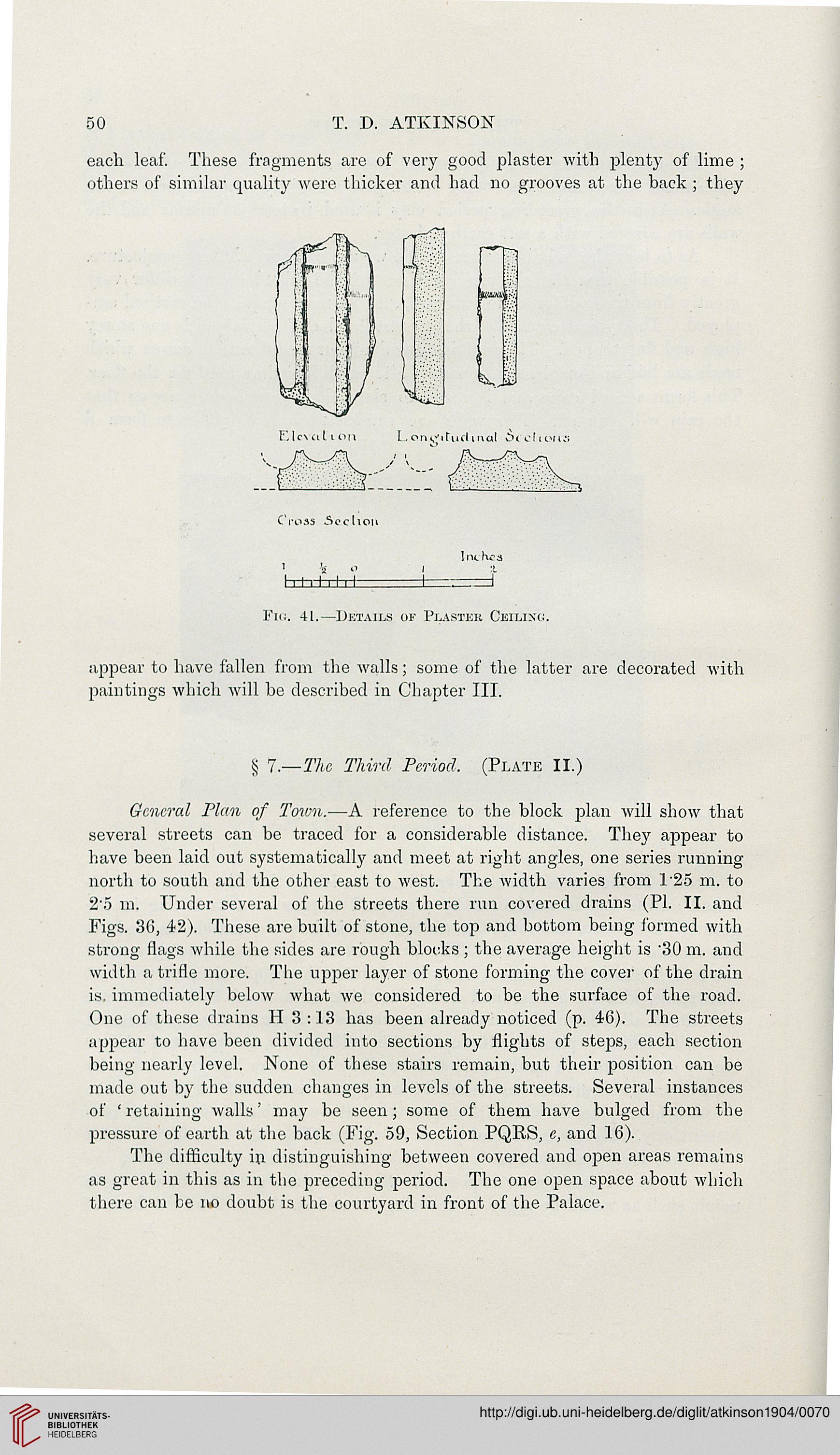50
T. D. ATKINSON
each leaf. These fragments are of very good plaster with plentj7 of lime ;
others of similar quality were thicker and bad no grooves at the back ; they
Inchea
b±rib±ri i -f
Fig. 41.—Details of Plaster Ceilino.
appear to have fallen from the walls; some of the latter are decorated with
paintings which will be described in Chapter III.
§ 7.—The Third Period. (Plate II.)
General Plan of Totun.—A reference to the block plan will show that
several streets can be traced for a considerable distance. They appear to
have been laid out systematically and meet at right angles, one series running
north to south and the other east to west. The width varies from 125 m. to
2"5 m. Und er several of the streets there run covered drains (PI. II. and
Figs. 3C, 42). These are built of stone, the top and bottom being formed with
strong flags while the sides are röugh blocks ; the average height is '30 m. and
width a trifle more. The upper layer of stone forming the covei' of the drain
i.s. immediately below what we considered to be the surface of the road.
One of these draius H 3 :13 has been already noticed (p. 46). The streets
appear to have been divided into sections by Hights of steps, each section
being nearly level. None of these stairs remain, but their position can be
made out by the sudden changes in levels of the streets. Several instances
of ' retaining walls' may be seen; some of them have bulged from the
pressure of earth at the back (Fig. 59, Section PQRS, e, and 16).
The difficulty in distinguishing between covered and open areas remains
as great in this as in the preceding period. The one open space about which
there can be no doubt is the courtyard in front of the Palace.
T. D. ATKINSON
each leaf. These fragments are of very good plaster with plentj7 of lime ;
others of similar quality were thicker and bad no grooves at the back ; they
Inchea
b±rib±ri i -f
Fig. 41.—Details of Plaster Ceilino.
appear to have fallen from the walls; some of the latter are decorated with
paintings which will be described in Chapter III.
§ 7.—The Third Period. (Plate II.)
General Plan of Totun.—A reference to the block plan will show that
several streets can be traced for a considerable distance. They appear to
have been laid out systematically and meet at right angles, one series running
north to south and the other east to west. The width varies from 125 m. to
2"5 m. Und er several of the streets there run covered drains (PI. II. and
Figs. 3C, 42). These are built of stone, the top and bottom being formed with
strong flags while the sides are röugh blocks ; the average height is '30 m. and
width a trifle more. The upper layer of stone forming the covei' of the drain
i.s. immediately below what we considered to be the surface of the road.
One of these draius H 3 :13 has been already noticed (p. 46). The streets
appear to have been divided into sections by Hights of steps, each section
being nearly level. None of these stairs remain, but their position can be
made out by the sudden changes in levels of the streets. Several instances
of ' retaining walls' may be seen; some of them have bulged from the
pressure of earth at the back (Fig. 59, Section PQRS, e, and 16).
The difficulty in distinguishing between covered and open areas remains
as great in this as in the preceding period. The one open space about which
there can be no doubt is the courtyard in front of the Palace.




